by Carol A Westbrook

Have you ever looked up at a dark night sky filled with millions of stars, and felt the wonder and awe of the universe? It’s a rare experience in 2020, since the night sky is so bright due to light pollution, that even the brightest stars appear dim. Fortunately, don’t need a dark sky to appreciate the wonder of the heavens; you only have to have a look at what today’s astronomers can see.
Astronomers now use telescopes that view with more wavelengths than the human eye can see, and process the images with advanced computing, to reveal fantastic visions that even Galileo could not have imagined as he turned his little telescope towards the moon and planets. Views of everything from our neighboring planets to planets in different solar systems, to distant galaxies and even black holes! Read on, I’ll show you some of my favorites from the skies of 2020.
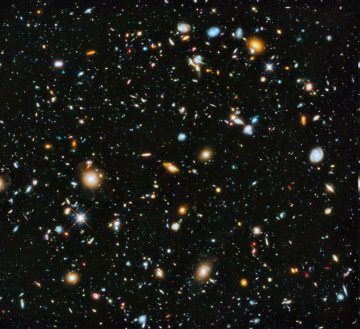
Our first stop is that most familiar of modern telescopes, the Hubble Space Telescope. Because Hubble is orbiting 350 miles above the earth, it is well above the clouds, light pollution, and atmospheric distortion that limit our view from down here. For over 30 years Hubble has captured images of outer space and relayed them back to the earth. The first few pictures that were released were almost beyond belief, as you can see in the figure. Who could ever have imagined how many galaxies were out there, and how beautifully they filled the heavens?
Hubble’s images are more than just pretty pictures. The data they contain is helping astronomers pin down the size and age of the universe, as well as features of the early universe, because light from the most distant stars originated many billions of years ago. Hubble examines our own system, too, because it can see so much more planetary detail than an earthbound telescope. It has obtained detailed observations of seasons of nearby planets, and discovered new moons of Pluto. It has even detected planets in solar systems other than our own, exoplanets
The first exoplanets were discovered about twenty years ago, and astronomers have been scouring the skies for them ever since. Initially thought to be rare, exoplanets are actually very common. As of January 2020, there are 4,108 confirmed exoplanets, and 2,430 potential planets! Most of these were discovered by the orbiting Kepler space telescope. The way Kepler finds planets is ingenious–it looks for stars whose brightness gets dimmer in a regular pattern. The star’s dimming is due to an orbiting planet that blocks out the light whenever it moves across the star. Most of the exoplanets recorded to date are very large, gas giants similar to Jupiter and Saturn, since they are the easiest to detect. Some of these planets have actually been viewed by telescopes, although this requires multiple observations and image analysis. The Hale telescope produced a picture of one such star system showing four planets, each more massive than 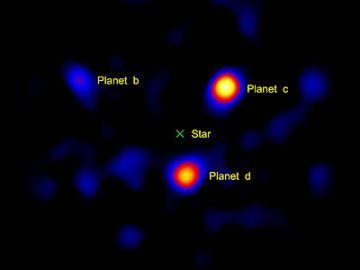 Jupiter, orbiting the young star HR 8799. Images like this really fire up my imagination. Think of how exciting it would be to visit this star system and see these planets close up–but since they are 127 light years away that’s not very likely.
Jupiter, orbiting the young star HR 8799. Images like this really fire up my imagination. Think of how exciting it would be to visit this star system and see these planets close up–but since they are 127 light years away that’s not very likely.
Planet-hunters are now actively seeking exoplanets that are more like our own: made of rocks instead of gas, closer in size to earth, and located in the “Goldilocks zone” of their star, where sunlight is neither too strong nor too weak. This distance is more likely the right temperature to have liquid water on its surface, with the best chances for life to exist. The closest earth-like planet is called Proxima Centauri b, which is about four light-years away. The planet is slightly larger than earth, and appears to be a rocky planet, in the Goldilocks zone of the dwarf red star Proxima 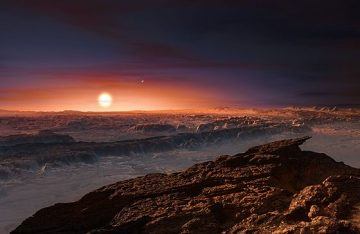 Centauri. Proxima Centauri b is only 4 light years away, which is within range of radio transmissions–as long as you are patient. Sadly, this planet is unlikely to support water-based life because it always keeps the same face to the sun, so the sun side is boiling hot, while the rear side is frozen. An artist’s depiction of the surface of Proxima Centauri b is shown on the left.
Centauri. Proxima Centauri b is only 4 light years away, which is within range of radio transmissions–as long as you are patient. Sadly, this planet is unlikely to support water-based life because it always keeps the same face to the sun, so the sun side is boiling hot, while the rear side is frozen. An artist’s depiction of the surface of Proxima Centauri b is shown on the left.
There are ongoing searches for rocky (non-gaseous) planets in the Goldilocks zone. One noteworthy project is called TESS, Transiting Exoplanet Survey Satellite. TESS is collecting an enormous amount of data for repeating patterns indicating a planet crossing its sun’s path. TESS project is relying on crowd sourcing to help, since the human brain is much better at finding these repeating patterns than is any computer program. If you want to learn more about TESS and are interested in participating at the next data release, check out the TESS planethunters’ zooniverse web site and register as a volunteer: Perhaps you’ll stumble on the signal that indicates a planet that has intelligent life!
If you’re interested in planets, you need look no further than our own solar system, where numerous probes have show us detailed images of all the known planets, and many asteroids. Mars is the host of several probes that have landed and are actively collecting data and looking for signs of water and life. There’s not enough space to go into detail about the planets, but you can read more and see some incredible pictures on the NASA site.
And if we’re looking for a sign of intelligent life–that is, radio signals–the best way to detect them is by radio telescope. My favorite telescope array is known as the Very Large Array (VLA), which is tuned to capture radio signals from space. Because these signals are so weak, and the 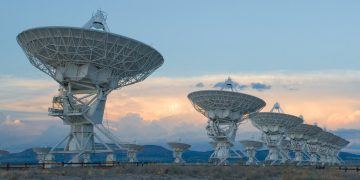 radio background from the earth is so high, scientists compensate by adding up the signals from many telescopes. The VLA is made up of 27 independent dishes, each of which has a diameter of 82 feet. The dishes are distributed over about 15 miles in Socorro, New Mexico. You may remember this array from the movie Contact.
radio background from the earth is so high, scientists compensate by adding up the signals from many telescopes. The VLA is made up of 27 independent dishes, each of which has a diameter of 82 feet. The dishes are distributed over about 15 miles in Socorro, New Mexico. You may remember this array from the movie Contact.
VLA observes objects that emit radio waves, many of which are invisible to conventional telescopes, such as radio galaxies quasars, pulsars, supernova remnants, gamma-ray bursts, black holes, and the hydrogen gas that constitutes much of the galaxy. A search of the galaxies M31 and M32 was conducted in December 2014 through January 2015 with the intent of quickly searching trillions of systems for extremely powerful signals from advanced civilizations–just like the movie Contact. So far no contact has been reported, but data analysis is ongoing. You never know…
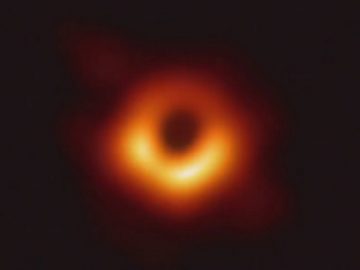 And we can’t forget one of the most significant discoveries of the century, the image of a real black hole–or rather of the material orbiting a black hole, known as the accretion disk. The image, shown here, is of a supermassive black hole at the center of the galaxy M87 was released April of last year. The M87 black hole is 53 million light years away, and is composed of matter that is equivalent to 6.5 billion times the mass of our sun. Capturing this picture required coordinated viewing of 8 telescopes around the world for a week, and is a story in itself. This planet-scale telescopic array is known as the EHT or Event Horizon Telescope, and it images gamma rays. If you want to inspire your imagination even more, have a look at this video made by the EHT group, zooming in to the heart of M87; it is an image of celestial beauty.
And we can’t forget one of the most significant discoveries of the century, the image of a real black hole–or rather of the material orbiting a black hole, known as the accretion disk. The image, shown here, is of a supermassive black hole at the center of the galaxy M87 was released April of last year. The M87 black hole is 53 million light years away, and is composed of matter that is equivalent to 6.5 billion times the mass of our sun. Capturing this picture required coordinated viewing of 8 telescopes around the world for a week, and is a story in itself. This planet-scale telescopic array is known as the EHT or Event Horizon Telescope, and it images gamma rays. If you want to inspire your imagination even more, have a look at this video made by the EHT group, zooming in to the heart of M87; it is an image of celestial beauty.
And I’ll close with one of my favorites, a 3-D map of the entire universe! This map was published in August by the University of Hawaii. Although there are other 3-D maps of the universe, this gives a much better sense of proportion since it is a video. The universe, which is now thought to be 93 billion light years in size, has considerably more structure than anyone realized, and is more beautiful than you could have imagined! Watch the video and take a brief journey through the 93 billion light-year span of the universe.
Astronomy has given us new eyes to see the heavens and has revealed things about the sky that I could never have imagined. We’ve had a glimpse of the beginnings of the universe, and had close up views of the surface of the planets, their moons and nearby asteroids. We’ve identified hundreds of exoplanets, some of which may have the capability to support life. In deep space, we’ve seen distant galaxies, the birthplace of stars, quasars, found evidence of dark matter, and even observed a black hole! Although neither us nor our spaceships will ever visit these far distant objects, which are millions of light years away, our horizons continue to expand as we learn more and more about our universe. So look to the skies, you’ll be surprised at what you can see. You can find some of the beautiful images and discoveries that these telescopes have made, as well as detailed information the telescopes, probes, and other space science at the NASA web site, nasa.gov.
